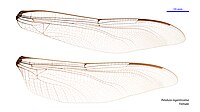Petalura ingentissima
| Giant petaltail | |
|---|---|

| |
| Type specimen held at the Natural History Museum, London | |
| Scientific classification | |
| Kingdom: | Animalia |
| Phylum: | Arthropoda |
| Class: | Insecta |
| Order: | Odonata |
| Infraorder: | Anisoptera |
| Family: | Petaluridae |
| Genus: | Petalura |
| Species: | P. ingentissima
|
| Binomial name | |
| Petalura ingentissima | |

| |
Petalura ingentissima, the giant petaltail, has been described as the world's largest dragonfly, with a wingspan of 160 mm.[3] It is found in Queensland, Australia.[4]
Dr R.J. Tillyard described the giant petaltail in 1908.[2] Its species name is derived from the Latin adjective ingens "huge". It is one of five species in the Australian genus Petalura.[5]
A large heavily built dragonfly,[5] the giant petaltail has a black body with some yellow markings.[6] The female's wingspan can be 158–162 mm and body length 125 mm, the largest dragonfly species in overall dimensions although members of the genus Tetracanthagyna can have longer wings and a larger wing area.[7]
Measuring 5.9-6.3 cm long,[6] the larvae are unusual in that they live in burrows along the river margin and hunt passing prey.[5]
Gallery[]

Female wings

Male wings
See also[]
References[]
| Wikimedia Commons has media related to Petalura ingentissima. |
| Wikispecies has information related to Petalura ingentissima. |
- ^ Dow, R.A. (2017). "Petalura ingentissima". IUCN Red List of Threatened Species. 2017: e.T87536260A87540079. doi:10.2305/IUCN.UK.2017-1.RLTS.T87536260A87540079.en. Retrieved 20 November 2021.
- ^ a b Tillyard, R. (1908). "On the genus Petalura, with description of a new species". Proceedings of the Linnean Society of New South Wales. 32: 708–718. doi:10.5962/bhl.part.19584 – via Biodiversity Heritage Library.
- ^ "Petalura ingentissima Tillyard". CSIRO website. CSIRO. 19 September 2004. Retrieved 14 May 2013.
- ^ "Species Petalura ingentissima Tillyard, 1908". Australian Faunal Directory. Australian Biological Resources Study. 2012. Retrieved 23 April 2017.
- ^ a b c "Petaluridae". What Bug is That - The Guide to Australian Insect Families. CSIRO. 2013. Retrieved 14 May 2013.
- ^ a b Günther Theischinger, John Henry Hawking (2006). The complete field guide to dragonflies of Australia. CSIRO Publishing. p. 110. ISBN 0643090738.
- ^ Silsby, Jill (2001). Dragonflies of the World. CSIRO Publishing. p. 37. ISBN 0643065121.
- IUCN Red List least concern species
- Petaluridae
- Odonata of Australia
- Insects of Australia
- Endemic fauna of Australia
- Taxa named by Robert John Tillyard
- Insects described in 1908


